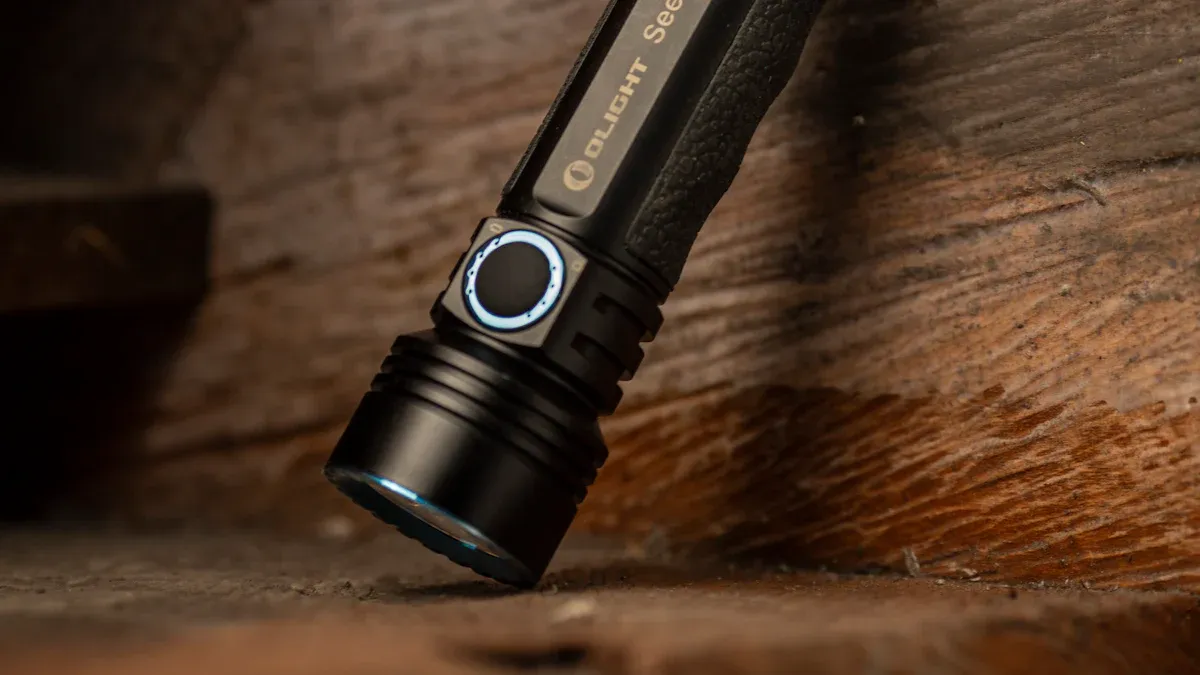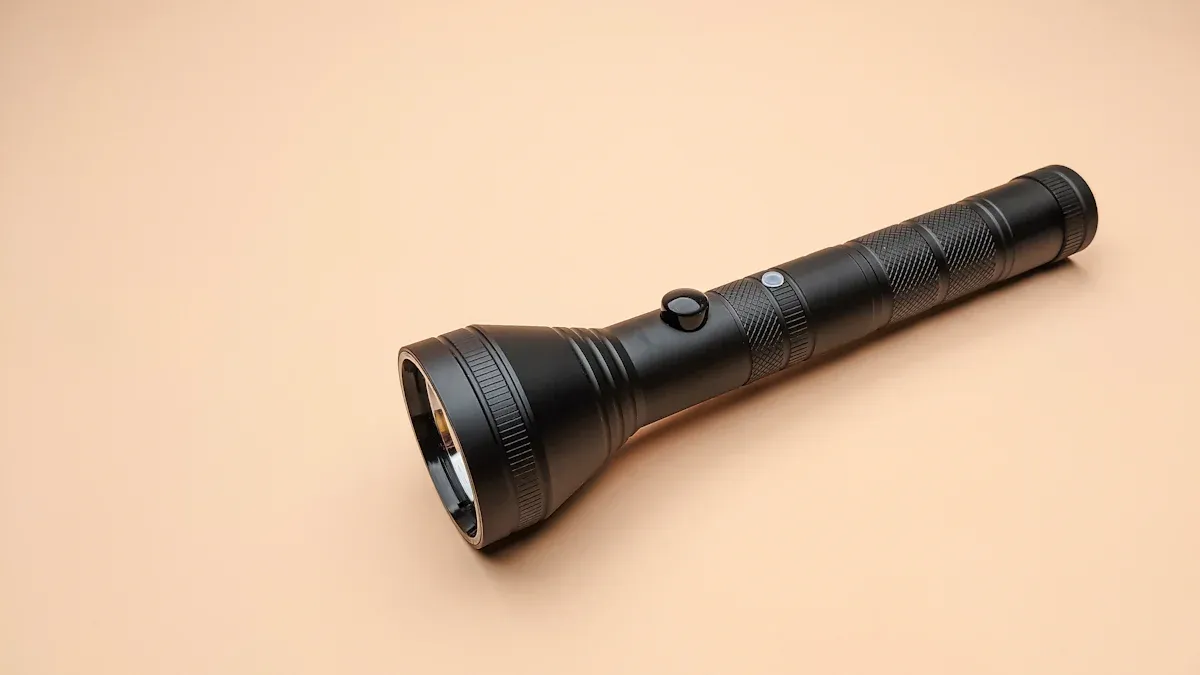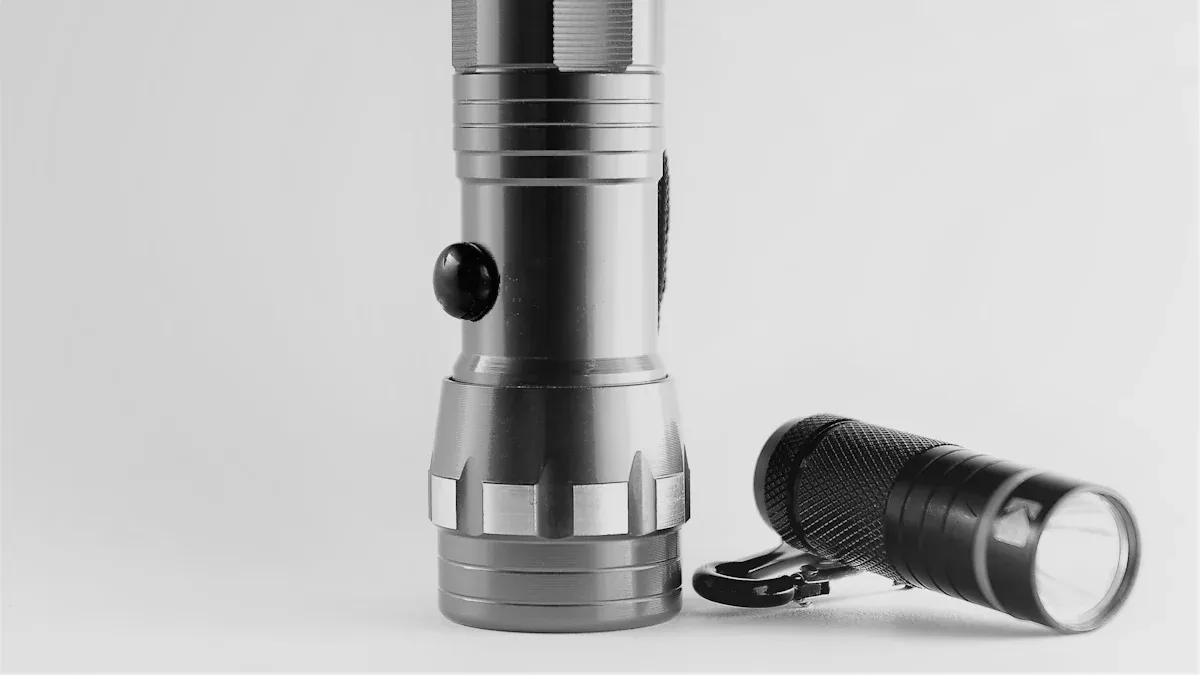How a flashlight can be a self-defense tool in dangerous situations

A flashlight is more than just a tool for lighting up dark spaces. It can become a vital self-defense tool in moments of danger. Tactical flashlights, such as the Helius flashlight, are designed to enhance your personal safety. Their high-powered beams can disorient attackers, giving you precious seconds to act. Features like strobe modes or strike bezels make them effective for self-defense. These flashlights not only illuminate but also protect, ensuring you stay prepared in uncertain situations.
Key Takeaways
A bright tactical flashlight can confuse attackers, giving you time to act.
Choose one with strobe mode and strong build for safety.
Practice holding and using it in different ways to feel ready.
What makes a tactical flashlight ideal for self-defense?

Definition and purpose of a tactical flashlight
A tactical flashlight is a specialized tool designed for high-performance use in tactical situations. Unlike regular flashlights, which are primarily for general illumination, tactical flashlights serve as effective self-defense tools. They are commonly used by military personnel, law enforcement officers, and individuals seeking enhanced personal safety. These flashlights combine intense brightness, durable construction, and advanced features to provide reliable performance in critical moments.
Key features that differentiate tactical flashlights from regular ones
Tactical flashlights stand out due to their unique design and functionality. Here are some key differences:
Built for tactical situations, they often exceed 1000 lumens, compared to the 100-500 lumens of regular flashlights.
Constructed from durable materials like aircraft-grade aluminum, they withstand extreme conditions.
Equipped with multiple modes, such as strobe and SOS, they offer versatility in emergencies.
Designed to be waterproof and shockproof, ensuring reliability in harsh environments.
Feature tail switches for quick activation and aggressive texturing for a secure grip.
These characteristics make tactical flashlights more than just a source of light—they are practical tools for personal defense.
Advantages of using a tactical flashlight for personal defense
Tactical flashlights offer several advantages as self-defense tools. Their high brightness can temporarily blind or disorient an attacker, giving you time to escape or respond. Their compact size ensures easy portability, allowing you to carry them in your pocket or bag. The durable construction means they can double as a striking tool if necessary. Additionally, features like strobe mode enhance their effectiveness in confusing threats. Unlike other self-defense tools, tactical flashlights are non-lethal, legal to carry, and serve dual purposes, making them an essential part of your personal defense strategy.
How to use a flashlight for self-defense

Identifying threats in low-light conditions
In dark environments, a flashlight becomes an essential self-defense tool for identifying threats. To avoid revealing your position, use momentary bursts of light to assess your surroundings. This technique allows you to locate potential threats while minimizing the risk of being detected. Follow these steps for effective use:
Turn the light on briefly.
Scan the area for threats.
Turn the light off.
Move to a new position.
Repeat as needed.
Keep the flashlight away from your center line to reduce the chance of becoming a target. Using a strobe effect can also disorientate attackers, giving you an advantage in low-light conditions.
Disorienting attackers with high-lumen brightness or strobe mode
A tactical flashlight with high-lumen output momentarily disorients attackers by overwhelming their vision. Direct the beam at an attacker’s eyes to create temporary blindness and confusion. Many tactical flashlights include a strobe mode, which enhances disorientation by emitting rapid flashes of light. This feature is particularly effective in dark environments, as it disrupts an attacker’s focus and gives you time to escape or respond.
Using the flashlight as a non-lethal striking tool
A tactical flashlight can serve as a non-lethal striking tool in self-defense. Hold the flashlight securely, ensuring the bezel edge faces downward for maximum impact. Position your thumb on the same side as the striking force to maintain control. Practice this grip regularly to improve your confidence and effectiveness. The durable construction of tactical flashlights makes them reliable for personal defense without causing permanent harm.
Signaling for help in emergencies
In emergency situations, a flashlight can be a lifesaver. Its beam can be visible from up to 18 miles away in clear conditions, making it an effective tool for signaling for help. For example, in backcountry emergencies, a flashlight has successfully signaled aircraft from significant distances. Even low-output lights can attract attention if used strategically. Use the SOS mode or wave the flashlight in a pattern to alert rescuers to your location.
Key features to look for in a tactical flashlight
High brightness and adjustable lumen output
When choosing a tactical flashlight, brightness is one of the most critical factors. A flashlight with a minimum of 120 lumens is sufficient for basic tasks, but for self-defense, you should opt for one with at least 500 lumens. This level of brightness can temporarily blind or disorient attackers, giving you a crucial advantage. Many tactical flashlights also offer adjustable lumen output, allowing you to switch between high and low settings depending on your needs. This flexibility ensures that your flashlight is effective in various situations, from illuminating dark areas to deterring potential threats.
Durable construction and weather resistance
A tactical flashlight must withstand harsh conditions. Look for models made from materials like aircraft-grade aluminum or reinforced polymers. These materials provide exceptional strength and longevity, ensuring your flashlight remains reliable even in rugged environments. Many tactical flashlights feature anodized finishes to prevent corrosion and are designed to be weather-resistant. This durability makes them suitable for outdoor adventures, emergencies, or self-defense scenarios where reliability is non-negotiable.
Compact size for portability and ease of use
Portability is another essential feature of a tactical flashlight. A compact flashlight, ideally between 3 to 6 inches, fits comfortably in your pocket, purse, or bag. Its small size ensures you can carry it discreetly without adding bulk. This convenience encourages regular use and ensures you always have it on hand when needed. A compact design also allows for quick access during emergencies, enhancing its usability in self-defense situations.
Additional features like beveled edges and strobe mode
Many tactical flashlights come with extra features that enhance their functionality. Beveled edges, for example, can serve as a striking tool in self-defense. Strobe mode is another valuable addition, as it emits rapid flashes of light to disorient attackers. These features, combined with high brightness and durable construction, make a tactical flashlight a versatile and effective tool for personal safety.
Practical tips for using a flashlight in self-defense
Proper grip and handling techniques
Mastering the correct grip and handling techniques is essential for using a tactical flashlight effectively as a self-defense tool. Here are some recommended methods:
Ice Pick Grip: Hold the flashlight at eye level to illuminate threats quickly.
Underarm Position: Tuck the flashlight under your arm for discreet use.
Two-Handed Techniques: Combine the flashlight with your shooting stance to enhance target illumination.
Other advanced techniques include:
FBI Technique: Extend the flashlight away from your body to misdirect an attacker’s aim.
Harries Technique: Position the flashlight below a firearm for added stability.
Neck-Index Technique: Use your neck and shoulder to support the flashlight for hands-free use.
Rogers Technique: Use a combat ring for a secure two-handed grip.
For striking, hold the flashlight with the bezel edge downward. Ensure your thumb aligns with the strike force for better control.
Positioning and aiming the light effectively
Positioning and aiming your flashlight strategically can maximize its effectiveness in self-defense. Use strobe mode to create temporary flash blindness, disorienting an attacker. A high-lumen flashlight can also create a "wall of light," overwhelming an intruder’s vision and stopping them in their tracks. To assess threats, use quick bursts of light to scan your surroundings without revealing your position. A focused beam aimed at an attacker’s eyes can temporarily blind them, giving you critical seconds to act.
Practicing situational awareness with a tactical flashlight
Carrying a tactical flashlight enhances your personal safety by improving situational awareness. In dark environments, it provides increased visibility, helping you navigate safely and avoid hazards. In threatening situations, the flashlight can disorient attackers, giving you time to escape or counter. During emergencies like power outages or roadside incidents, it ensures you have a reliable light source. Regular practice with your flashlight helps you respond confidently in high-stress scenarios.
Combining a flashlight with other personal defense tools
Pairing a tactical flashlight with other personal defense tools can improve your overall safety. The flashlight enhances visibility, allowing you to navigate and identify threats effectively. It can also blind and disorient attackers, creating opportunities to use other tools. For example, combining a mounted light with a handheld flashlight prepares you for both lethal and non-lethal situations. This approach ensures comprehensive preparedness and flexibility in emergencies.
A tactical flashlight, like the Helius flashlight, is an indispensable self-defense tool. Its high-lumen brightness disorients attackers, while its durable construction ensures reliability in emergencies. When choosing a flashlight for personal defense, prioritize features like compact size, strobe mode, and robust materials. By practicing its use, you can enhance your safety and confidence in dangerous situations. Investing in a high-quality tactical flashlight prepares you for unexpected threats and ensures you stay protected.
FAQ
What is the ideal brightness level for a tactical flashlight?
You should choose a flashlight with at least 500 lumens. This brightness level effectively disorients attackers and provides sufficient illumination for self-defense situations.
Can I carry a tactical flashlight on a plane?
Yes, you can carry a tactical flashlight in your checked luggage. However, confirm with your airline to ensure compliance with their specific regulations.
How do I maintain my tactical flashlight?
Clean the lens regularly with a soft cloth. Check the battery and replace it as needed. Store the flashlight in a dry, cool place to prevent damage.
See Also
Selecting The Ideal Self-Defense Device: Laser Or Flashlight?
Advantages Of Using Rechargeable Flashlights For Community Safety
Comparing Police Flashlights And Regular Ones: What’s Superior?
